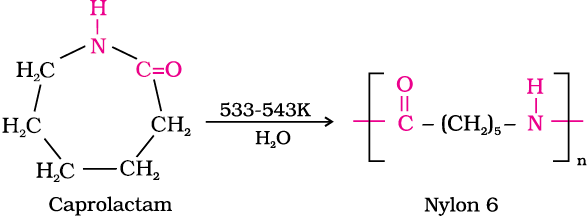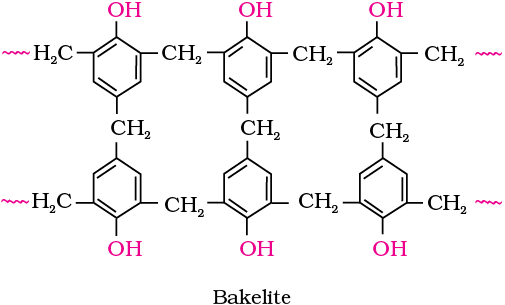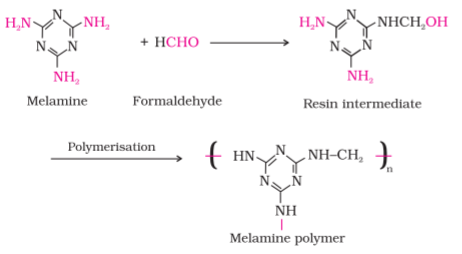Table of Contents
Unit 15
Polymers
Objectives
After studying this Unit, you will be able to
- explain the terms - monomer, polymer and polymerisation and appreciate their importance;
- distinguish between various classes of polymers and different types of polymerisation processes;
- appreciate the formation of polymers from mono- and bi-functional monomer molecules;
- describe the preparation of some important synthetic polymers and their properties;
- appreciate the importance of polymers in daily life.
Do you think that daily life would have been easier and colourful without the discovery and varied applications of polymers? The use of polymers in the manufacture of plastic buckets, cups and saucers, children’s toys, packaging bags, synthetic clothing materials, automobile tyres, gears and seals, electrical insulating materials and machine parts has completely revolutionised the daily life as well as the industrial scenario. Indeed, the polymers are the backbone of four major industries viz. plastics, elastomers, fibres and paints and varnishes.
The word ‘polymer’ is coined from two Greek words: poly means many and mer means unit or part. The term polymer is defined as very large molecules having high molecular mass (103-107u). These are also referred to as macromolecules, which are formed by joining of repeating structural units on a large scale. The repeating structural units are derived from some simple and reactive molecules known as monomers and are linked to each other by covalent bonds. The process of formation of polymers from respective monomers is called polymerisation.
15.1 Classification of Polymers
There are several ways of classification of polymers based on some special considerations. One of the common classifications of polymers is based on source from which polymer is derived.
Under this type of classification, there are three sub categories.
1. Natural polymers
These polymers are found in plants and animals. Examples are proteins, cellulose, starch, some resins and rubber.
2. Semi-synthetic polymers
Cellulose derivatives as cellulose acetate (rayon) and cellulose nitrate, etc. are the usual examples of this sub category.
3. Synthetic polymers
Polymers can also be classified on the basis of their structure, molecular forces or modes of polymerisation.
Intext Questions
15.1 What are polymers ?
15.2 Types of Polymerisation
There are two broad types of polymerisation reactions, i.e., the addition or chain growth polymerisation and condensation or step growth polymerisation.
15.2.1 Addition Polymerisation or Chain Growth Polymerisation
In this type of polymerisation, the molecules of the same monomer or diferent monomers add together on a large scale to form a polymer. The monomers used are unsaturated compounds, e.g., alkenes, alkadienes and their derivatives. This mode of polymerisation leads to an increase in chain length and chain growth can take place through the formation of either free radicals or ionic species. However, the free radical governed addition or chain growth polymerisation is the most common mode.
15.2.1.1 Mechanism of Addition Polymerisation
1. Free radical mechanism
A variety of alkenes or dienes and their derivatives are polymerised in the presence of a free radical generating initiator (catalyst) like benzoyl peroxide, acetyl peroxide, tert-butyl peroxide, etc. For example, the polymerisation of ethene to polythene consists of heating or exposing to light a mixture of ethene with a small amount of benzoyl peroxide initiator. The process starts with the addition of phenyl free radical formed by the peroxide to the ethene double bond thus generating a new and larger free radical. This step is called chain initiating step. As this radical reacts with another molecule of ethene, another bigger sized radical is formed. The repetition of this sequence with new and bigger radicals carries the reaction forward and the step is termed as chain propagating step. Ultimately, at some stage the product radical thus formed reacts with another radical to form the polymerised product. This step is called the chain terminating step. The sequence of steps involved in the formation of polythene are depicted as follows:
Chain initiation steps

Chain propagating step

Chain terminating step
For termination of the long chain, these free radicals can combine in different ways to form polythene. One mode of termination of chain is shown as under:

The addition polymers formed by the polymerisation of a single monomeric species are known as homopolymers, for example polythene discussed above is a homopolymer.
The polymers made by addition polymerisation from two different monomers are termed as copolymers. Buna-S, which is formed by polymerisation of buta–1, 3–diene and styrene is an example of copolymer formed by addition polymerisation.

15.2.1.2 Some Important Addition Polymers
(a) Polythene
Polythenes are linear or slightly branched long chain molecules. These are capable of repeatedly softening on heating and hardening on cooling and are thus thermoplastic polymers.
There are two types of polythene as given below:
(i) Low density polythene: It is obtained by the polymerisation of ethene under high pressure of 1000 to 2000 atmospheres at a temperature of 350 K to 570 K in the presence of traces of dioxygen or a peroxide initiator (catalyst). The low density polythene (LDP) is obtained through the free radical addition and H-atom abstraction. It has highly branched structure. These polymers have straight chain structure with some branches as shown below.

Low density polythene is chemically inert and tough but flexible and a poor conductor of electricity. Hence, it is used in the insulation of electricity carrying wires and manufacture of squeeze bottles, toys and flexible pipes.
(ii) High density polythene: It is formed when addition polymerisation of ethene takes place in a hydrocarbon solvent in the presence of a catalyst such as triethylaluminium and titanium tetrachloride (Ziegler-Natta catalyst) at a temperature of 333 K to 343 K and under a pressure of 6-7 atmospheres. High density polythene (HDP) thus produced, consists of linear molecules as shown below and has a high density due to close packing. Such polymers are also called linear polymers. High density polymers are also chemically inert and more tough and hard. It is used for manufacturing buckets, dustbins, bottles, pipes, etc.

(b) Polytetrafluoroethene (Teflon)
Teflon is manufactured by heating tetrafluoroethene with a free radical or persulphate catalyst at high pressures. It is chemically inert and resistant to attack by corrosive reagents. It is used in making oil seals and gaskets and also used for non – stick surface coated utensils.

(c) Polyacrylonitrile
The addition polymerisation of acrylonitrile in presence of a peroxide catalyst leads to the formation of polyacrylonitrile.

Polyacrylonitrile is used as a substitute for wool in making commercial fibres as orlon or acrilan.
Example 15.1
Is  a homopolymer or a copolymer?
a homopolymer or a copolymer?
Solution
It is a homopolymer and the monomer from which it is obtained is styrene C6H5CH = CH2.
15.2.2 Condensation Polymerisation or Step Growth Polymerisation
This type of polymerisation generally involves a repetitive condensation reaction between two bi-functional or trifunctional mono-meric units. These polycondensation reactions may result in the loss of some simple molecules as water, alcohol, hydrogen chloride, etc., and lead to the formation of high molecular mass condensation polymers.
In these reactions, the product of each step is again a bi-functional species and the sequence of condensation goes on. Since, each step produces a distinct functionalised species and is independent of each other, this process is also called as step growth polymerisation.
The formation of terylene or dacron by the interaction of ethylene glycol and terephthalic acid is an example of this type of polymerisation.

15.2.2.1 Some Important Condensation Polymers
(a) Polyamides
These polymers possessing amide linkages are important examples of synthetic fibres and are termed as nylons. The general method of preparation consists of the condensation polymerisation of diamines with dicarboxylic acids or condensation of amino acids or their lactams.
Nylons
(i) Nylon 6,6: It is prepared by the condensation polymerisation of hexamethylenediamine with adipic acid under high pressure and at high temperature.

Nylon 6, 6 is fibre forming solid. It possess high tensile strength. This characteristic can be attributed to the strong intermolecular forces like hydrogen bonding. These strong forces also lead to close packing of chains and thus impart crystalline nature.
Nylon 6, 6 is used in making sheets, bristles for brushes and in textile industry.
(ii) Nylon 6: It is obtained by heating caprolactum with water at a high temperature.

Nylon 6 is used for the manufacture of tyre cords, fabrics and ropes.
(b) Polyesters
These are the polycondensation products of dicarboxylic acids and diols. Dacron or terylene is the best known example of polyesters. It is manufactured by heating a mixture of ethylene glycol and terephthalic acid at 420 to 460 K in the presence of zinc acetate-antimony trioxide catalyst as per the reaction given earlier. Dacron fibre (terylene) is crease resistant and is used in blending with cotton and wool fibres and also as glass reinforcing materials in safety helmets, etc.


Novolac on heating with formaldehyde undergoes cross linking to form an infusible solid mass called bakelite. It is thermosetting polymer which cannot be reused or remoulded. Thus, bakelite is formed by cross linking of linear chains of the polymer novolac. Bakelite is used for making combs, phonograph records, electrical switches and handles of various utensils.

Melamine formaldehyde polymer is formed by the condensation polymerisation of melamine and formaldehyde.
It is used in the manufacture of unbreakable crockery.
Intext Questions
15.2 Write the names of monomers of the following polymers:



15.3 Classify the following as addition and condensation polymers: Terylene, Bakelite, Polythene, Teflon.
15.2.3 Copolymerisation

Copolymers have properties quite different from homopolymers. For example, butadiene - styrene copolymer is quite tough and is a good substitute for natural rubber. It is used for the manufacture of autotyres, floortiles, footwear components, cable insulation, etc.
15.2.4 Rubber
1. Natural rubber
Rubber is a natural polymer and possesses elastic properties. It is also termed as elastomeric polymer. In elastomeric polymers, the polymer chains are held together by the weak intermolecular forces. These weak binding forces permit the polymer to be stretched. A few ‘crosslinks’ are introduced in between the chains, which help the polymer to retract to its original position after the force is released.
Rubber has a variety of uses. It is manufactured from rubber latex which is a colloidal dispersion of rubber in water. This latex is obtained from the rubber tree which is found in India, Srilanka, Indonesia, Malaysia and South America.
Natural rubber may be considered as a linear polymer of isoprene (2-methyl-1, 3-butadiene) and is also called as cis - 1, 4 - polyisoprene.

 The cis-polyisoprene molecule consists of various chains held together by weak van der Waals interactions and has a coiled structure. Thus, it can be stretched like a spring and exhibits elastic properties.
The cis-polyisoprene molecule consists of various chains held together by weak van der Waals interactions and has a coiled structure. Thus, it can be stretched like a spring and exhibits elastic properties.
Vulcanisation of rubber: Natural rubber becomes soft at high temperature (>335 K) and brittle at low temperatures (<283 K) and shows high water absorption capacity. It is soluble in non-polar solvents and is non-resistant to attack by oxidising agents. To improve upon these physical properties, a process of vulcanisation is carried out. This process consists of heating a mixture of raw rubber with sulphur and an appropriate additive at a temperature range between 373 K to 415 K. On vulcanisation, sulphur forms cross links at the reactive sites of double bonds and thus the rubber gets stiffened.
In the manufacture of tyre rubber, 5% of sulphur is used as a crosslinking agent. The probable structures of vulcanised rubber molecules are depicted below:

2. Synthetic rubbers
Preparation of Synthetic Rubbers
1. Neoprene
Neoprene or polychloroprene is formed by the free radical polymerisation of chloroprene.

It has superior resistance to vegetable and mineral oils. It is used for manufacturing conveyor belts, gaskets and hoses.
2. Buna – N
You have already studied about Buna-S, in Section 15.1.3. Buna –N is obtained by the copolymerisation of 1, 3 – buta–1, 3–diene and acrylonitrile in the presence of a peroxide catalyst.

It is resistant to the action of petrol, lubricating oil and organic solvents. It is used in making oil seals, tank lining, etc.
15.3 Molecular Mass of Polymers
Polymer properties are closely related to their molecular mass, size and structure. The growth of the polymer chain during their synthesis is dependent upon the availability of the monomers in the reaction mixture. Thus, the polymer sample contains chains of varying lengths and hence its molecular mass is always expressed as an average. The molecular mass of polymers can be determined by chemical and physical methods.
15.4 Biodegradable Polymers
A large number of polymers are quite resistant to the environmental degradation processes and are thus responsible for the accumulation of polymeric solid waste materials. These solid wastes cause acute environmental problems and remain undegraded for quite a long time. In view of the general awareness and concern for the problems created by the polymeric solid wastes, certain new biodegradable synthetic polymers have been designed and developed. These polymers contain functional groups similar to the functional groups present in biopolymers.
Aliphatic polyesters are one of the important classes of biodegradable polymers. Some important examples are given below:

2. Nylon 2–nylon 6
It is an alternating polyamide copolymer of glycine (H2N–CH2–COOH) and amino caproic acid [H2N (CH2)5 COOH] and is biodegradable. Can you write the structure of this copolymer?
15.5 Polymers of Commercial Importance
Besides, the polymers already discussed, some other commercially important polymers along with their structures and uses are given below in Table 15.1.
Table 15.1: Some Other Commercially Important Polymers
| Name of Polymer | Monomer | Structure | Uses |
|---|---|---|---|
Polypropene | Propene |  | Manufacture of ropes, toys, pipes, fibres, etc. |
Polystyrene | Styrene |  | As insulator, wrapping material, manufacture of toys, radio and television cabinets. |
Polyvinyl chloride (PVC) | Vinyl chloride |  | Manufacture of rain coats, hand bags, vinyl flooring, water pipes. |
Urea-formaldehyle Resin | (a) Urea (b) Formaldehyde |  | For making unbreak-able cups and laminated sheets. |
| Glyptal | (a) Ethylene glycol (b) Phthalic acid |  | Manufacture of paints and lacquers. |
Bakelite | (a) Phenol (b) Formaldehyde |  | For making combs, electrical switches, handles of utensils and computer discs. |
Summary
Polymers are defined as high molecular mass macromolecules, which consist of repeating structural units derived from the corresponding monomers. These polymers may be of natural or synthetic origin and are classified in a number of ways.
In the presence of an organic peroxide initiator, the alkenes and their derivatives undergo addition polymerisation or chain growth polymerisation through a free radical mechanism. Polythene, teflon, orlon, etc. are formed by addition polymerisation of an appropriate alkene or its derivative. Condensation polymerisation reactions are shown by the interaction of bi – or poly functional monomers containing – NH2, – OH and – COOH groups. This type of polymerisation proceeds through the elimination of certain simple molecules as H2O, CH3OH, etc. Formaldehyde reacts with phenol and melamine to form the corresponding condensation polymer products. The condensation polymerisation progresses through step by step and is also called as step growth polymerisation. Nylon, bakelite and dacron are some of the important examples of condensation polymers. However, a mixture of two unsaturated monomers exhibits copolymerisation and forms a co-polymer containing multiple units of each monomer. Natural rubber is a cis 1, 4-polyisoprene and can be made more tough by the processof vulcanisation with sulphur. Synthetic rubbers are usually obtained by copolymerisation of alkene and 1, 3 butadiene derivatives.
In view of the potential environmental hazards of synthetic polymeric wastes, certain biodegradable polymers such as PHBV and Nylon-2- Nylon-6 are developed as alternatives.
Exercises
15.1 Explain the terms polymer and monomer.
15.2 What are natural and synthetic polymers? Give two examples of each type.
15.3 Distinguish between the terms homopolymer and copolymer and give an example of each.
15.4 How do you explain the functionality of a monomer?
15.5 Define the term polymerisation.
15.6 Is ( NH-CHR-CO )n, a homopolymer or copolymer?
15.7 Why do elastomers possess elastic properties?
15.8 How can you differentiate between addition and condensation polymerisation?
15.9 Explain the term copolymerisation and give two examples.
15.10 Write the free radical mechanism for the polymerisation of ethene.
15.11 Define thermoplastics and thermosetting polymers with two examples of each.
15.12 Write the monomers used for getting the following polymers.
(i) Polyvinyl chloride (ii) Teflon (iii) Bakelite
15.13 Write the name and structure of one of the common initiators used in free radical addition polymerisation.
15.14 How does the presence of double bonds in rubber molecules influence their structure and reactivity?
15.15 Discuss the main purpose of vulcanisation of rubber.
15.16 What are the monomeric repeating units of Nylon-6 and Nylon-6,6?
15.17 Write the names and structures of the monomers of the following polymers:
(i) Buna-S (ii) Buna-N (iii) Dacron (iv) Neoprene
15.18 Identify the monomer in the following polymeric structures.
(i)

(ii)

15.19 How is dacron obtained from ethylene glycol and terephthalic acid ?
15.20 What is a biodegradable polymer ? Give an example of a biodegradable aliphatic polyester.
Answers of Some Intext Questions
15.1 Polymers are high molecular mass substances consisting of large numbers of repeating structural units. They are also called as macromolecules. Some examples of polymers are polythene, bakelite, rubber, nylon 6, 6, etc.
15.2 (i) Hexamethylene diamine and adipic acid.
(ii) Caprolactam.
(iii) Tetrafluoroethene.
15.3 Addition polymers: Polyvinyl chloride, Polythene.
Condensation polymers: Terylene, Bakelite.
15.4 Buna-N is a copolymer of 1,3-butadiene and acrylonitrile and Buna-S is a copolymer of 1,3-butadiene and styrene.
15.5 In order of increasing intermolecular forces.
Buna-S, Polythene, Nylon 6,6.

